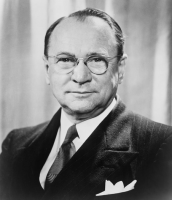










Vladimir Zworykin was born in Murom, 200 miles east of Moscow, and studied electrical engineering at the Imperial Institute of Technology. Boris Rosing, a professor in charge of laboratory projects, tutored Zworykin and introduced his student to his experiments of transmitting pictures by wire. Together they experimented with a very early cathode-ray tube, developed in Germany by Karl Ferdinand Braun.
Rosing and Zworykin exhibited a television system in 1910, using a mechanical scanner in the transmitter and the electronic Braun tube in the receiver.
Rosing disappeared during the Bolshevik Revolution of 1917. Zworykin escaped and briefly studied X-rays under Paul Langevin in Paris, before moving to the United States in 1919, to work at the Westinghouse laboratory in Pittsburgh.
On November 18, 1929, at a convention of radio engineers, Zworykin demonstrated a television receiver containing his kinescope.
Radio Corporation of America
Vladimir Zworykin was transferred by Westinghouse to work for the Radio Corporation of America (RCA) in Camden, New Jersey, as the new director of the Electronic Research Laboratory. RCA owned most of Westinghouse at that time and had just bought the Jenkin's Television Company, makers of mechanical television systems, in order to receive their patents (see C. F. Jenkins).
Zworykin made improvements to his iconoscope, RCA funded his research to the tune of $150,000. The further improvements allegedly used an imaging section which was similar to Philo Farnsworth's patented dissector. Patent litigation forced RCA to start paying Farnsworth royalties.
IEEE Medal of Honor, IEEE Edison Medal, Rumford Prize, Faraday Medal, National Medal of Science for Physical Science